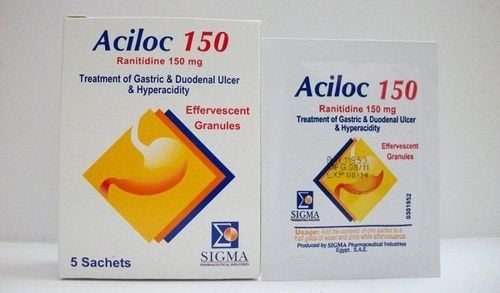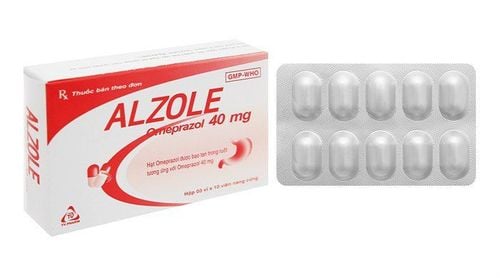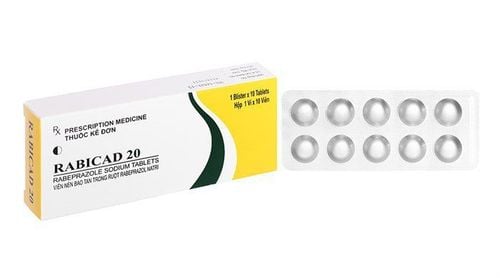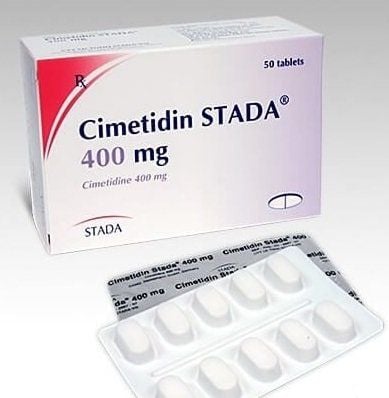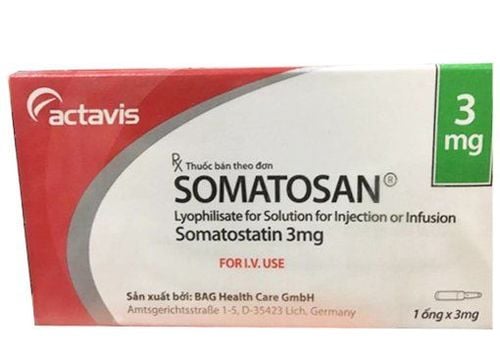This is an automatically translated article.
Omsergy drug is recommended by specialists for people with gastrointestinal diseases such as duodenal ulcer, esophagitis with syndromes such as Zollinger - Ellison, reflux esophagitis. The following article will provide more about the effects and how to use omsergy 20mg effectively.1. What is omsergy 20mg?
Omsergy has the main ingredient is Omeprazole of the group of gastrointestinal drugs, prepared in the form of hard capsules with a strength of 20 mg.
Omsergy capsules contain the enteric-coated, granular formulation of Omeprazole (because Omeprazole is a labile acid). Therefore, the absorption of Omeprazole begins only after the granules leave the stomach. Absorption is rapid, with peak plasma concentrations of omeprazole occurring within 0.5 to 3.5 hours. Peak plasma concentrations of Omeprazole and AUC are approximately proportional to the dose up to 40 mg, but because the first pass effect may be saturating, a linear response is higher than peak plasma concentrations and AUC occurs. with doses greater than 40 mg. Absolute bioavailability (compared to intravenous administration) is approximately 30 to 40% at 20 to 40 mg doses, largely due to systemic pre-metabolism. In healthy subjects, the plasma half-life is 0.5 to 1 hour, and the total body clearance is 500 to 600 mL/min.
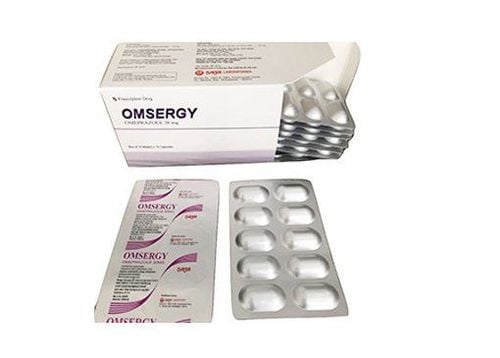
Omsergy có tác dụng điều trị các bệnh đường tiêu hóa
Based on a relative bioavailability study, the maximum AUC and C for Omsergy for delayed-release oral suspension were 87% and 88% of Omeprazole for the delayed-release capsule, respectively. The bioavailability of Omeprazole is slightly increased with repeated administration of Omsergy extended-release capsules.
In addition, the distribution of omsergy 20 mg in healthy subjects has an apparent volume of approximately 0.3 l/kg body weight. Omeprazole is up to 97% bound to plasma proteins.
Bioconversion of Omsergy 20mg is extensively metabolized by the cytochrome P450 (CYP) enzyme system. The major part of metabolism depends on the polymorphic CYP2C19, responsible for the formation of Hydroxy Omeprazole, the major plasma metabolite. The remainder depends on CYP3A4 responsible for the formation of Omeprazole sulphone.
Approximately 3% of the Caucasian population and 15-20% of the Asian population are deficient in the functional CYP2C19 enzyme and are referred to as poor metabolizers. In these individuals, the metabolism of Omeprazole is primarily catalyzed by CYP3A4. After maintenance administration of 20 mg Omeprazole once daily, the mean AUC in poor metabolizers was 5 to 10 times higher than in subjects with a functional CYP2C19 enzyme (heavy metabolizers). Mean peak plasma concentrations in poor metabolisers were also 3 to 5 times higher.
Excretion of Omsergy 20mg after a single oral dose most of the dose (approximately 77%) is excreted in the urine as at least six metabolites. Two substances were identified as Omeprazole Hydroxide and Carboxylic Acids, respectively. The remainder of the dose will be excreted in the feces. This implies significant biliary excretion of omeprazole's metabolites. Three metabolites have been identified in plasma, the sulfide and sulfone derivatives of Omeprazole and the hydroxyde Omeprazole. These metabolites have little or no antisecretory activity.
In addition, the AUC of Omeprazole increased with repeated administration. This dose-dependent increase resulted in a non-linear dose-AUC relationship after maintenance dosing. This time and dose dependence is due to a decrease in first-pass metabolism and systemic clearance possibly caused by inhibition of the CYP2C19 enzyme by omeprazole and its metabolites (e.g. sulfones). No metabolites were found to have any effect on gastric acid secretion.

Omsergy 20mg được chỉ định trong điều trị trào ngược dạ dày thực quản
2. What does Omsergy do?
2.1. Indications of the drug Omsergy 20mg
For adults:
Treatment of duodenal ulcer Prevention of recurrence of duodenal ulcer Treatment of gastric ulcer Prevention of recurrence of gastric ulcer In combination with appropriate antibiotics, eradication of Helicobacter pylori (H. pylori) in peptic ulcer disease Treatment of NSAID-associated gastric and duodenal ulcers Prevention of NSAID-associated gastric and duodenal ulcers in at-risk patients Treatment of reflux esophagitis Long-term management of the disease patients with healed reflux esophagitis Treatment of symptomatic gastroesophageal reflux disease Treatment of Zollinger-Ellison syndrome
For children:
Children over 1 year and 10 kg Treatment of reflux esophagitis Symptomatic treatment of heartburn and acid reflux in gastroesophageal reflux disease Children and adolescents over 4 years of age In combination with antibiotics in the treatment of duodenal ulcers caused by H. pylori
2.2. Contraindications of omsergy 20mg
Do not administer Omsergy to any patient who is allergic to any part of the drug. Not for use by pregnant and lactating women

Thuốc Omsergy 20mg không dùng cho phụ nữ có thai
2.3. Mechanism of action of the drug Omsergy 20mg
Omeprazole belongs to the class of antisecretory compounds, replacing Benzimidazole, which blocks gastric acid secretion by specifically inhibiting the H +/K + ATPase enzyme system at the secretory surface of cells located on the gastric wall. This enzyme system is considered to be the acid (proton) pump located in the gastric mucosa, Omeprazole has been characterized as a gastric acid pump inhibitor, in that it prevents the final step of acid production. This effect is dose related and results in inhibition of both basal and excitatory acid secretion regardless of the stimulus.After oral administration, the antisecretory effect of Omsergy begins to occur within an hour, with maximum effects occurring within two hours. Suppression of secretion was approximately 50% of the maximum at 24 h and the duration of inhibition lasted up to 72 h. Consequently, the antisecretory effect is much more prolonged than would be expected from a very short plasma half-life (less than one hour), likely due to prolonged binding to the parietal H +/K + ATPase enzyme. When the drug is discontinued, the secretory activity returns gradually, over 3 to 5 days. Omsergy's inhibitory effect on acid secretion increased with repeated once-daily dosing, reaching steady state after four days.
Daily oral doses of Omsergy ranging from 10 mg to 40 mg have 100% suppressed gastric acidity for 24 hours in some patients.
In studies of 200 patients, serum gastrin concentrations increased during the first 1 to 2 weeks of once-daily therapeutic doses of Omsergy in parallel with suppression of gastric acid secretion. No further increase in serum gastrin was observed with continued treatment. Compared with histamine H2-receptor antagonists, the mean increase produced by the 20mg dose of Omsergy was higher (1.3 to 3.6 times vs 1.1 to 1.8 times). Gastrin values return to pre-treatment levels, usually within 1 to 2 weeks after stopping treatment.
Increased gastrin causes Enterochromaffin-like cell hyperplasia and increased serum Chromogranin A (CgA) levels. Elevated CgA levels may cause false-positive results in diagnostic investigations of neuroendocrine tumors.
Systemic effects of Omsergy on the central nervous, cardiovascular and respiratory systems have not been found to date. Omsergy, given in oral doses of 30 or 40 mg for 2 to 4 weeks, has no effect on thyroid function, carbohydrate metabolism, or circulating levels of parathyroid hormone, testosterone, estradiol, prolactin, cholecystokinin cortisol, or secrettin .
No systemic dose-dependent effects were observed on basal or excitatory pepsin output in humans.
However, when the pH in the stomach is maintained at 4.0 or higher, basal pepsin production is low and pepsin activity is reduced.
As with other agents that increase pH in the stomach, Omsergy taken for 14 days in healthy subjects significantly increased the concentration of bacteria living in the stomach. The pattern of the bacterial species did not change from the pattern normally found in saliva. All changes resolved within three days of stopping treatment.
2.4. Side effects of Omsergy 20mg

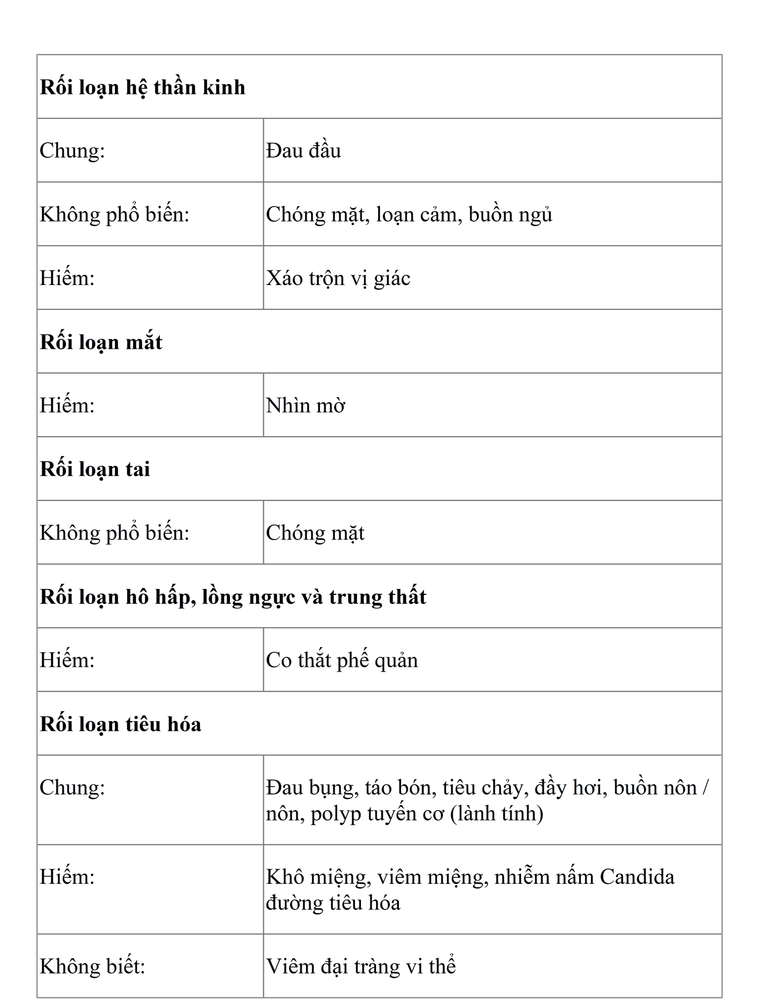
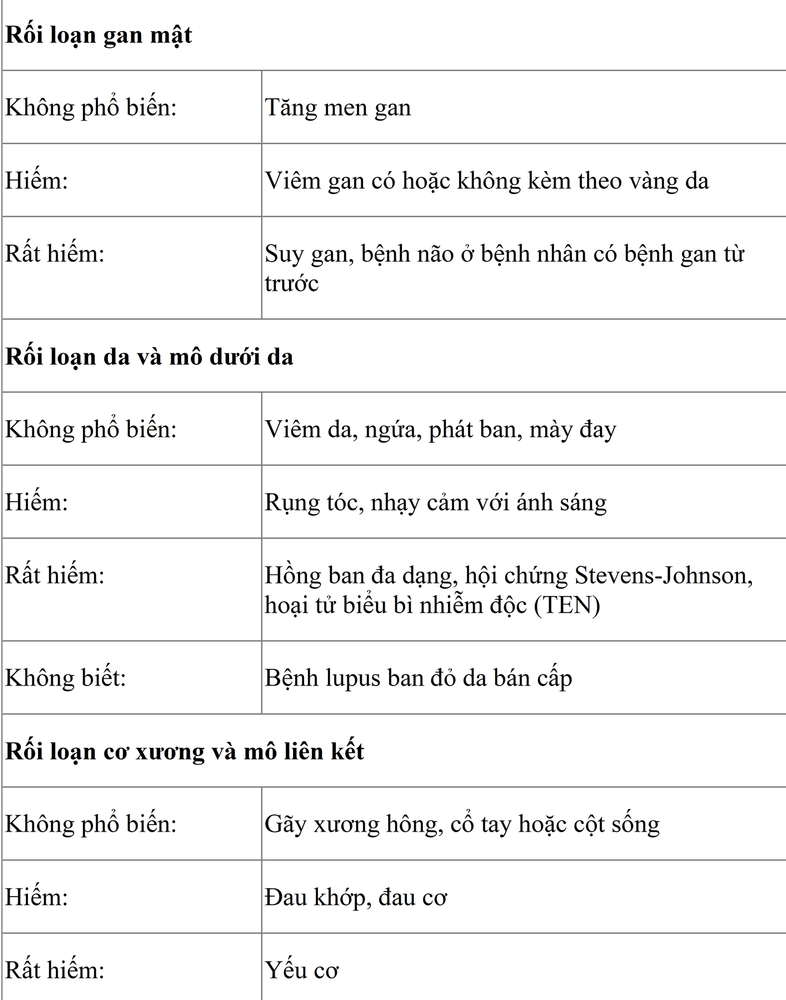
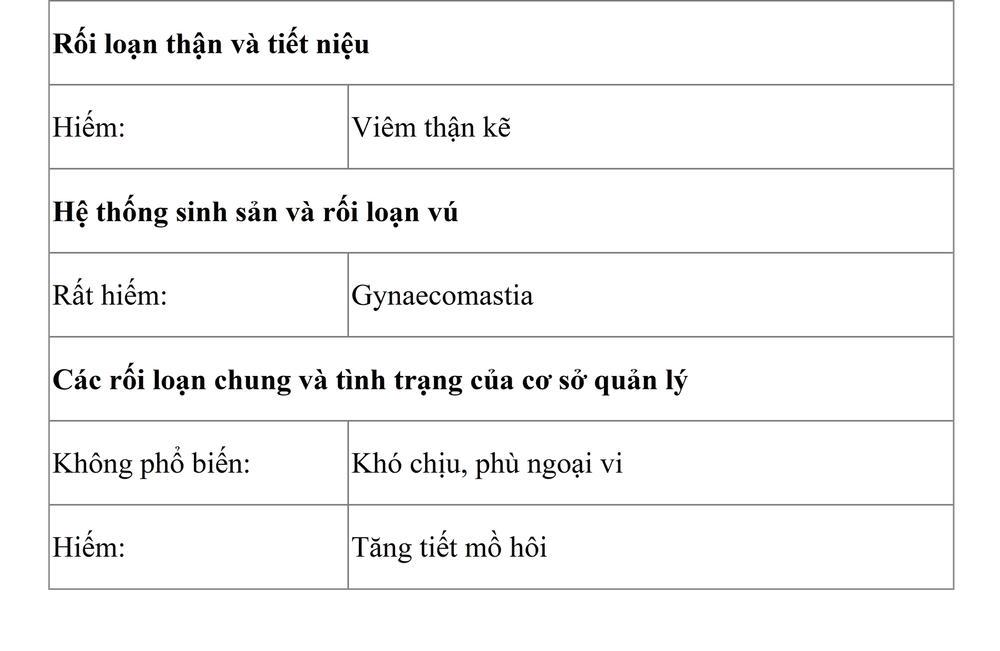
2.5. Overdose when taking Omsergy 20mg
There is currently no antidote specifically for Omsergy , all just symptomatic treatment. Symptoms include: Blurred vision, confusion, flushed skin, night sweats, heart palpitations, nausea.

Người bệnh nên thận trọng khi sử dụng Omsergy 20mg
2.6. Drug interactions
Concomitant use of Omsergy with Nelfinavir is contraindicated. Concomitant administration of Omeprazole (40 mg once/day) reduced mean case-by-case Nelfinavir exposure. 40% and mean exposure of the pharmacologically active metabolite M8 was decreased by case. 75-90%. Interactions may also involve inhibition of CYP2C19.
Co-administration of Omsergy with Atazanavir is not recommended. Co-administration of Omeprazole (40 mg once daily) and Atazanavir 300 mg/ Ritonavir 100 mg to healthy volunteers reduced Atazanavir exposure by 75%. Increasing the dose of Atazanavir to 400 mg was not sufficient to resolve the effects of Omeprazole on Atazanavir exposure. Co-administration of Omsergy (20 mg once daily) with Atazanavir 400 mg/ Ritonavir 100 mg to healthy volunteers reduced Atazanavir exposure by approximately 30% compared with Atazanavir 300 mg/ ritonavir 100 mg once daily. / day.
Concomitant treatment with Omsergy (20 mg daily) and Digoxin in healthy subjects increased the bioavailability of Digoxin by 10%. Digoxin toxicity has rarely been reported. However, caution should be exercised when omeprazole is used in high doses in elderly patients. Thereafter, increased monitoring of the therapeutic agent Digoxin is required.
Absorption of ketoconazole, erlotinib, posaconazole and itraconazole is significantly reduced and thus clinical efficacy may be impaired. Therefore, posaconazole and erlotinib should be avoided concomitantly with Omsergy.
Concomitant administration of Omsergy with saquinavir/ritonavir increases plasma drug concentrations by up to approximately 70% for saquinavir with respect to good tolerability in HIV-infected patients.
3. How to use omsergy 20mg
3.1. Duodenal Ulcer Treatment The recommended dose in patients with advanced duodenal ulcer is Omsergy 20 mg once daily. In most patients, healing occurs within two weeks. For patients who may not be fully healed after the first course, healing usually occurs within an additional two-week treatment period. In patients with poorly responsive duodenal ulcers, a dose of 40 mg once daily is recommended and healing is usually achieved within 4 weeks.
3.2. Prevention of duodenal ulcer recurrence Prevention of duodenal ulcer recurrence in patients with H. pylori negative results or when H. pylori cannot be eradicated, the recommended dose is Omsergy 20 mg once as a single dose. / day. But for some people, a daily dose of 10 mg may be enough. In case of unsuccessful treatment, the dose can be increased to 40 mg.
3.3. Treatment of gastric ulcers The recommended dose is Omsergy 20 mg once daily. In most patients, healing occurs within four weeks. For patients who may not be completely healed after the first course, healing usually occurs during the next four weeks of treatment. In patients with poorly responsive peptic ulcers, a dose of 40 mg once daily is recommended and usually heals within 8 weeks.
3.4. Prevention of recurrent peptic ulcer disease For the prevention of recurrence in poorly responsive peptic ulcer patients, the recommended dose is Omsergy 20 mg once daily. Depending on the patient's condition, the dose may be increased to Omsergy 40 mg once daily.
3.5. Eradication of H. pylori in peptic ulcer disease To eradicate H. pylori, antibiotic selection should consider the individual patient's tolerability and should be done in accordance with treatment guidelines and guidelines. national, regional and local drug resistance patterns.
Omsergy 20 mg, Clarithromycin 500 mg, Amoxicillin 1,000 mg, twice daily for one week Omsergy 20 mg, Clarithromycin 250 mg (alternatively 500 mg), Metronidazole 400 mg (or 500 mg or Tinidazole 500 mg), twice daily for one week Omsergy 40 mg once daily with Amoxicillin 500 mg and Metronidazole 400 mg (or 500 mg or Tinidazole 500 mg), both times a day for one week. In each regimen, if the patient remains positive for H. pylori, the above therapy will be considered so that it can be repeated.
3.6. Treatment of NSAID-associated gastric and duodenal ulcers For the treatment of NSAID-associated gastric and duodenal ulcers, the recommended dose is Omsergy 20 mg once daily. In most patients, healing occurs within four weeks. For patients who may not be completely healed after the first course, healing usually occurs during the next four weeks of treatment.
3.7. Prevention of NSAID-associated gastric and duodenal ulcers in at-risk patients and duodenum, history of upper gastrointestinal bleeding), the recommended dose is Omsergy 20 mg once daily.
3.8. Treatment of reflux esophagitis The recommended dose is Omsergy 20 mg once daily. In most patients, healing occurs within four weeks. For patients who may not be completely healed after the first course, healing usually occurs during the next four weeks of treatment.
In patients with severe esophagitis, a dose of 40 mg once daily is recommended and disease is usually achieved within 8 weeks.
3.9. Long-term management of patients with healed reflux esophagitis The recommended dose is Omsergy 10 mg once daily. If necessary, the dose can be increased to Omsergy 20-40 mg once daily.
3.10. Symptomatic treatment of gastroesophageal reflux disease - The recommended dose is Omsergy 20 mg daily. Patients may respond adequately to 10 mg daily, and therefore individual dose adjustments should be considered.
If symptom control is still not achieved after 4 weeks of treatment with Omsergy 20 mg daily, further investigation is recommended.
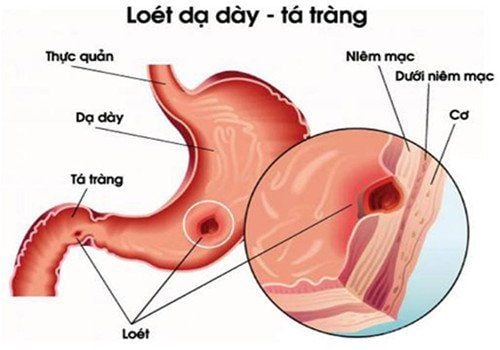
Thuốc Omsergy điều trị loét dạ dày tá tràng
3.11. Treatment of Zollinger-Ellison syndrome In patients with Zollinger-Ellison syndrome, dosage should be individually adjusted and treatment continued for as long as clinically indicated. The recommended starting dose is Omsergy 60 mg per day. All patients with severe disease and inadequate response to other therapies were effectively controlled and more than 90% of patients maintained on Omsergy 20 - 120 mg daily. When the dose exceeds Omsergy 80 mg daily, the dose should be divided and administered twice daily.
3.12. Young children Children over 1 year old and weighing ≥ 10 kg
Treatment of esophagitis that is caused by reflux Treatment of the most common symptoms of heartburn and acid reflux in gastroesophageal reflux disease Dosage recommendations are as follows:
| Tuổi | Trọng lượng | Liều dùng |
| ≥ 1 tuổi | 10 - 20 kg | 10 mg x 1 lần/ ngày. Nếu cần thiết tăng liều lên 20 mg x 1 lần/ ngày |
| ≥ 2 tuổi | > 20 kg | 20 mg x 1 lần / ngày. Nếu cần thiết tăng liều lên 40 mg x 1 lần / ngày nếu cần |
Reflux esophagitis: Treatment time is from 4 to 8 weeks. Treatment of gastroesophageal reflux disease with symptoms of heartburn and acid reflux: The duration of treatment is from 2 to 4 weeks. If symptoms are not controlled after 2-4 weeks, the patient should be examined further. Children over 4 years old
Treatment of duodenal ulcers caused by H. pylori When choosing a combination treatment method, it is necessary to take a careful history of allergies, combine antibiotic therapy if necessary for about 7 to 14 days. and consider the use of appropriate antimicrobial agents. Treatment requires the supervision of a specialist. Dosage recommendations are as follows:
| Trọng lượng | Liều dùng |
| 15 - 30 kg | Kết hợp hai loại kháng sinh: Omsergy 10 mg, amoxicillin 25 mg / kg thể trọng và clarithromycin 7,5 mg/ kg thể trọng, tất cả được dùng cùng nhau hai lần mỗi ngày trong một tuần |
| 31 - 40 kg | Kết hợp với hai loại kháng sinh: Omsergy 20 mg, amoxicillin 750 mg và clarithromycin 7,5 mg/ kg thể trọng, tất cả được dùng hai lần mỗi ngày trong một tuần |
| > 40 kg | Kết hợp hai loại kháng sinh: Omsergy 20 mg, amoxicillin 1 g và clarithromycin 500 mg, tất cả đều được dùng hai lần mỗi ngày trong một tuần. |
Please dial HOTLINE for more information or register for an appointment HERE. Download MyVinmec app to make appointments faster and to manage your bookings easily.




